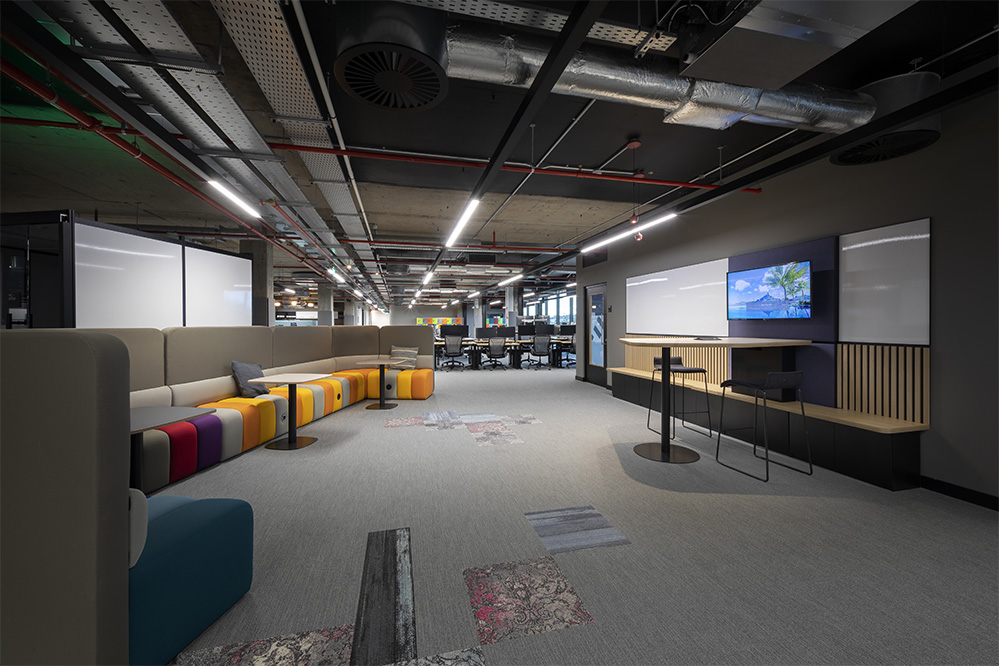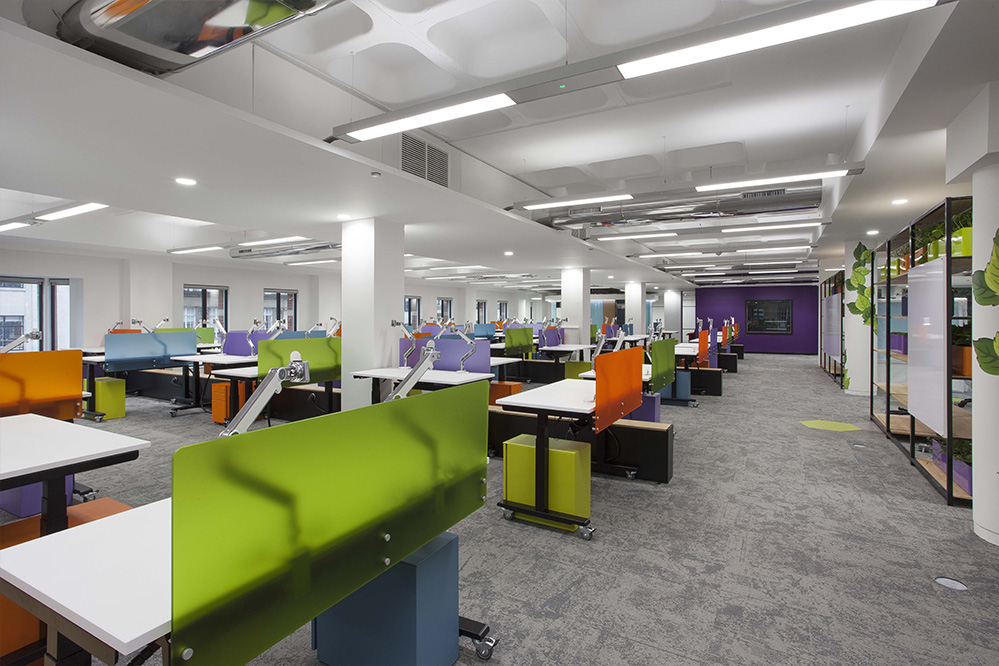Flexible Office Furniture: 4 Things FMs Need to Know
The pandemic, and our subsequent return to the office have made the need for high-performing workspaces more important than ever. For Facility Managers (FMs) charged with translating employees’ new wants and behaviours into engaging and agile environments – it’s a challenge that can be solved, in part, with a greater focus on flexibility.
Hybrid working is the new normal and so office spaces are becoming transient hubs for collaboration and community, rather than merely places for head-down, desk-based work. Collaboration and teamwork are important to 75%[1] of employees and 17%[2] are more satisfied when collaboration is part of their work – so employers, FMs and therefore workplaces must meet these needs if they are to support productivity, wellbeing and retention.

Flutter’s global HQ in Dublin embraces collaboration with this teamwork space, complete with Scrumwall.
However adapting to new employee needs isn’t an event, but rather a mindset. FMs need to ensure that workplaces continually offer flexibility – both in terms of how space is used on a daily basis, and also how it can evolve and adapt to meet the longer-term strategic needs of an organisation.

DP World in Southampton has embraced flexible office furniture with the use of flip-top tables so that spaces can be reconfigured, and furniture moved with ease.
Office furniture gives space form, function and flexibility. It presents a whole world of possibilities. It can make even the smallest workplace accommodate multiple different needs and styles. It can promote choice, aid well-being and support employees with an increasingly task-orientated approach to work. It can make one office floorplate able to accommodate shifting requirements over numerous years.
Consequently there are four flexible office furniture considerations FMs need to know in order to shape and enhance the post-pandemic workplace:
1. Sit Stand: Designed in response to sedentary office behaviours, sit-stand desks help employees to move more and promote greater choice. While the widespread adoption of these desks is still in the early stages (most employers apportion 10-20% of their desking to sit stand), some organisations have been quick to champion sit stand flexibility. Interactive entertainment company King is one such example. We designed a mobile sit-stand desk solution so their team could manage their personal comfort and reconfigure furniture easily as their needs changed. These desks changed their collaborative dynamic and made it possible for mini-teams to coalesce easily – whether that’s moving desks into mini huddles or simply rotating them 90 degrees to face their colleagues.

Games developer King has made good use of Staverton’s mobile sit-stand desks so their team could manage their personal comfort and reconfigure furniture easily as needs change.
2. Space-defining Structures: Flexible office furniture can help to zone open-plan spaces. Our recent development of TT, a modular grid-based shelving system and Scrumwall are perfect examples. Both are space-defining structures with a high degree of functionality and user engagement, thanks to a wide variety of add-ons such as standing tables, lockers, write-on surfaces, and integrated AV. Furniture of this ilk enables numerous different work settings to radiate from one central spine and provides a cost-effective way to adapt spaces and create distinct zones within large open floor plates. Other furniture in this category includes high-backed seating booths, storage systems and self-contained meeting pods – all of which create spaces within spaces and boast multiple uses.

Sky Bet Leeds used Scrumwall with standing height tables and integrated AV add-ons to help define different spaces and provide extra areas for impromptu gatherings and meetings.
3. Alternative Meeting Spaces: Not all meetings are face-to-face. Not all meetings need to be held in private meeting rooms. In fact, impromptu collaboration and quick team meetings can be best supported with more informal and flexible spaces that also serve other uses. This might be achieved with den-style office furniture – typically semi-enclosed soft seating which offers acoustic privacy and comfort in equal measure – or through touch-down spaces. More collaborative team gatherings may require a meeting room, but kitchen table project setting or informal company presentation areas provide other useful options, while conference calls or video meetings are best suited to individual phone and AV booths, where acoustics and privacy have been fully considered. Spaces with multiple uses have greater value.

Staverton TT gives Flutter’s collaborative kitchen a sense of separation from the main floorplate, while our kitchen tables provide ample spaces for team lunches and informal meetings.
4. Easy to Move: Whether it’s being able to quickly pull up extra seating to a collaboration table or distinguishing an area to accommodate a new team – the modern office needs furniture that is quick and easy to move when required. This doesn’t have to mean everything on castors either, as designers and manufacturers have engineering solutions that are light and simple to move and set up.
Flexibility is at the very core of the hybrid working concept. For FMs striving to create agile workplaces that work for today and tomorrow, flexible office furniture offers a valuable win-win.
To learn more about how our British office furniture can support workplace mobility for your organisation, contact us via 020 3794 1200 or email info@staverton.co.uk
This blog is an edited extract from a guest article written by our Managing Director Paul Edward for industry magazine FMJ. You can read the full article here.
[1] Research from Zippia as quoted here: https://www.zippia.com/advice/workplace-collaboration-statistics/
[2] Research from Zippia as quoted here: https://www.zippia.com/advice/workplace-collaboration-statistics/




